Chalcone-1-Deoxynojirimycin Heterozygote Reduced the Blood Glucose Concentration and Alleviated the Adverse Symptoms and Intestinal Flora Disorder of Diabetes Mellitus Rats
Abstract
:1. Introduction
2. Materials and Methods
2.1. Chemicals and Materials
2.2. Animals and Diets
2.3. In Vivo Experiments Design
2.4. Determination of Body Weight, Food and Water Intake
2.5. Fasting Blood Glucose Test Method
2.6. Postprandial Blood Glucose Test Method
2.7. Visceral Organs Collection and Organ Coefficient Determination
2.8. Blood/Serum Biochemical Analysis
2.9. Preparation and Staining of Sections
2.10. Detection and Analysis of Gut Microbiota
2.10.1. Collection of Intestinal Contents
2.10.2. Extraction and Sequencing of DNA
2.10.3. Bioinformatic Analysis and Statistics
2.11. Statistical Analysis
3. Results
3.1. Effects of DC-5 on Postprandial Blood Glucose in Normal Rats
3.2. Effect of DC-5 on FBG and PBG in Diabetic Rats
3.2.1. Effects of DC-5 on FBG in Diabetic Rats
3.2.2. Effects of DC-5 on PBG in Diabetic Rats
3.3. Effects of DC-5 on Body Weight, Water Intake and Food Intake of Diabetic Rats
3.3.1. Effects of DC-5 on Body Weight in Diabetic Rats
3.3.2. Effects of DC-5 on Water Intake of Diabetic Rats
3.3.3. Effects of DC-5 on Food Intake of Diabetic Rats
3.4. Effects of DC-5 on Blood Biochemical Indexes of Diabetic Rats
3.4.1. DC-5 Improved Serum Lipid Profiles of Diabetic Rats
3.4.2. Protective Effects of DC-5 on Liver and Kidney of Diabetic Rats
3.5. Histological Analysis of Diabetic Rats Treated by DC-5
3.5.1. Analysis of Liver Tissue Sections
3.5.2. Analysis of Kidney Tissue Sections
3.5.3. Analysis of Small Intestinal Tissue Sections
3.6. Overall Structural Modulation of Gut Microbiota in Diabetic Rats Treated by DC-5
3.6.1. Analysis of Population Diversity
3.6.2. Alpha Diversity Analysis
3.6.3. Beta Diversity Analysis
3.7. Community Composition Change Analysis of Gut Microbiota in Diabetic Rats Treated by DC-5
4. Discussion
5. Conclusions
Supplementary Materials
Author Contributions
Funding
Institutional Review Board Statement
Informed Consent Statement
Data Availability Statement
Conflicts of Interest
Abbreviations
References
- Okutan, L.; Kongstad, K.T.; Jäger, A.K.; Staerk, D. High-resolution α-amylase assay combined with high-performance liquid chromatography-solid-phase extraction-nuclear magnetic resonance spectroscopy for expedited identification of α-amylase inhibitors: Proof of concept and α-amylase inhibitor in cinnamon. J. Agric. Food Chem. 2014, 62, 11465–11471. [Google Scholar] [CrossRef] [PubMed]
- Cardullo, N.; Muccilli, V.; Pulvirenti, L.; Cornu, A.; Pouységu, L.; Deffieux, D.; Quideau, S.; Tringali, C. C-glucosidic ellagitannins and galloylated glucoses as potential functional food ingredients with anti-diabetic properties: A study of α-glucosidase and α-amylase inhibition. Food Chem. 2019, 313, 126099. [Google Scholar] [CrossRef] [PubMed]
- Evans, J.M.M.; Newton, R.W.; Ruta, D.A.; MacDonald, T.M.; Morris, A.D. Socio-economic status, obesity and prevalence of Type 1 and Type 2 diabetes mellitus. Diabet. Med. 2010, 17, 478–480. [Google Scholar] [CrossRef]
- Ling, C.; Rönn, T. Epigenetics in Human Obesity and Type 2 Diabetes. Cell Metab. 2019, 29, 1028–1044. [Google Scholar] [CrossRef] [Green Version]
- Caspard, H.; Jabbour, S.; Hammar, N.; Fenici, P.; Sheehan, J.J.; Kosiborod, M. Recent trends in the prevalence of type 2 diabetes and the association with abdominal obesity lead to growing health disparities in the USA: An analysis of the NHANES surveys from 1999 to 2014. Diabetes Obes. Metab. 2018, 20, 667–671. [Google Scholar] [CrossRef] [Green Version]
- Cavalot, F.; Petrelli, A.; Traversa, M.; Bonomo, K.; Fiora, E.; Conti, M.; Anfossi, G.; Costa, G.; Trovati, M. Postprandial Blood Glucose Is a Stronger Predictor of Cardiovascular Events Than Fasting Blood Glucose in Type 2 Diabetes Mellitus, Particularly in Women: Lessons from the San Luigi Gonzaga Diabetes Study. J. Clin. Endocrinol. Metab. 2006, 91, 813–819. [Google Scholar] [CrossRef] [Green Version]
- Hanefeld, M.; Fischer, S.; Julius, U.; Schulze, J.; Schwanebeck, U.; Schmechel, H.; Ziegelasch, H.J.; Lindner, J. Risk factors for myocardial infarction and death in newly detected NIDDM: The Diabetes Intervention Study, 11-year follow-up. Diabetologia 1996, 39, 1577–1583. [Google Scholar] [CrossRef]
- Cavalot, F.; Pagliarino, A.; Valle, M.; Martino, L.D.; Bonomo, K.; Massucco, P.; Anfossi, G.; Trovati, M. Postprandial Blood Glucose Predicts Cardiovascular Events and All-Cause Mortality in Type 2 Diabetes in a 14-Year Follow-Up: Lessons from the San Luigi Gonzaga Diabetes Study. Diabetes Care 2011, 34, 2237–2243. [Google Scholar] [CrossRef] [Green Version]
- Mima, A. Renal protection by sodium-glucose cotransporter 2 inhibitors and its underlying mechanisms in diabetic kidney disease. J. Diabetes Its Complicat. 2018, 32, 720–725. [Google Scholar] [CrossRef]
- Warren, A.M.; Knudsen, S.T.; Cooper, M.E. Diabetic nephropathy: An insight into molecular mechanisms and emerging therapies. Expert Opin. Ther. Targets 2019, 23, 1–13. [Google Scholar] [CrossRef]
- Davis, H.; Briscoe, V.J.; Dumbadze, S.; Davis, S.N. Using DPP-4 inhibitors to modulate beta cell function in type 1 diabetes and in the treatment of diabetic kidney disease. Expert Opin. Investig. Drugs 2019, 28, 377–388. [Google Scholar] [CrossRef] [PubMed]
- Bhattacharjee, N.; Barma, S.; Konwar, N.; Dewanjee, S.; Manna, P. Mechanistic insight of diabetic nephropathy and its pharmacotherapeutic targets: An update. Eur. J. Pharmacol. 2016, 791, 8–24. [Google Scholar] [CrossRef] [PubMed]
- Panagiotis, I.G.; Rajiv, A. Endothelin A receptor antagonists in diabetic kidney disease. Curr. Opin. Nephrol. Hypertens. 2017, 26, 338–344. [Google Scholar] [CrossRef]
- Gupta, S.; Goyal, P.; Feinn, R.S.; Mattana, J. Role of Vitamin D and Its Analogues in Diabetic Nephropathy: A Meta-analysis. Am. J. Med. Sci. 2019, 357, 223–229. [Google Scholar] [CrossRef] [PubMed]
- Kobayashi, K.; Yokoh, H.; Sato, Y.; Takemoto, M.; Uchida, D.; Kanatsuka, A.; Kuribayashi, N.; Terano, T.; Hashimoto, N.; Sakurai, K.; et al. Efficacy and safety of the dipeptidyl peptidase-4 inhibitor sitagliptin compared with α-glucosidase inhibitor in Japanese patients with type 2 diabetes inadequately controlled on sulfonylurea alone (SUCCESS-2): A multicenter, randomized, open-label, non-inferiority trial. Diabetes Obes. Metab. 2014, 16, 761–765. [Google Scholar] [CrossRef]
- Nishioka, T.; Kawabata, J.; Aoyama, Y. Baicalein, an α-Glucosidase Inhibitor from Scutellaria baicalensis. J. Nat. Prod. 1998, 61, 1413–1415. [Google Scholar] [CrossRef]
- Raptis, S.A.; Dimitriadis, G.D. Oral hypoglycemic agents: Insulin secretagogues, α-glucosidase inhibitors and insulin sensitizers. Exp. Clin. Endocrinol. Diabetes 2001, 109, S265–S287. [Google Scholar] [CrossRef]
- Habtemariam, S. A-glucosidase inhibitory activity of kaempferol-3-O-rutinoside. Nat. Prod. Commun. 2011, 6, 201–203. [Google Scholar] [CrossRef] [Green Version]
- Chiasson, J.-L.; Gomis, R.; Hanefeld, M.; Josse, R.G.; Karasik, A.; Laakso, M.; The Stop-Niddm Trial Research Group. The STOP-NIDDM Trial: An international study on the efficacy of an α-glucosidase inhibitor to prevent type 2 diabetes in a population with impaired glucose tolerance: Rationale, design, and preliminary screening data. Diabetes Care 1998, 21, 1720. [Google Scholar] [CrossRef]
- Courageot, M.-P.; Frenkiel, M.-P.; Santos, C.D.D.; Deubel, V.; Desprès, P. α-Glucosidase Inhibitors Reduce Dengue Virus Production by Affecting the Initial Steps of Virion Morphogenesis in the Endoplasmic Reticulum. J. Virol. 2000, 74, 564. [Google Scholar] [CrossRef]
- De Melo, E.B.; da Silveira Gomes, A.; Carvalho, I. α- and β-Glucosidase inhibitors: Chemical structure and biological activity. Cheminform 2007, 62, 10277–10302. [Google Scholar] [CrossRef]
- Liu, Y.-j.; Zhu, J.; Yu, J.-M.; Chen, X.; Zhang, S.-Y.; Cai, Y.-X.; Li, L. A new functionality study of vanillin as the inhibitor for α-glucosidase and its inhibition kinetic mechanism. Food Chem. 2021, 353, 129448. [Google Scholar] [CrossRef] [PubMed]
- Ali, F.; Khan, K.M.; Salar, U.; Taha, M.; Ismail, N.H.; Wadood, A.; Riaz, M.; Perveen, S. Hydrazinyl arylthiazole based pyridine scaffolds Synthesis, structural characterization, invitro α-glucosidase inhibitory activity, and in silico studies. Eur. J. Med. Chem. 2017, 138, 255–272. [Google Scholar] [CrossRef]
- Reuser, A.J.J.; Wisselaar, H.A. An evaluation of the potential side-effects of alpha-glucosidase inhibitors used for the management of diabetes mellitus. Eur. J. Clin. Investig. 2010, 24, 19–24. [Google Scholar] [CrossRef] [PubMed]
- Li, Y.-G.; Ji, D.-F.; Zhong, S.; Lin, T.-B.; Lv, Z.-Q.; Hu, G.-Y.; Wang, X. 1-Deoxynojirimycin inhibits glucose absorption and accelerates glucose metabolism in streptozotocin-induced diabetic mice. Sci. Rep. 2013, 3, 1377. [Google Scholar] [CrossRef] [PubMed] [Green Version]
- Mitrakou, A.; Tountas, N.; Raptis, A.; Bauer, R.; Schulz, H.; Raptis, S. Long-term effectiveness of a new α-glucosidase inhibitor (BAY m1099-miglitol) in insulin-treated Type 2 diabetes mellitus. Diabet. Med. 1998, 15, 657–660. [Google Scholar] [CrossRef]
- Yu, L.; Ikeda, K.; Kato, A.; Adachi, I.; Godin, G.; Compain, P.; Martin, O.; Asano, N. α-1-C-Octyl-1-deoxynojirimycin as a pharmacological chaperone for Gaucher disease. Bioorganic Med. Chem. 2006, 14, 7736–7744. [Google Scholar] [CrossRef]
- Godin, G.; Compain, P.; Martin, O.R.; Ikeda, K.; Yu, L.; Asano, N. α-1-C-Alkyl-1-deoxynojirimycin derivatives as potent and selective inhibitors of intestinal isomaltase: Remarkable effect of the alkyl chain length on glycosidase inhibitory profile. Bioorganic Med. Chem. Lett. 2004, 14, 5991–5995. [Google Scholar] [CrossRef]
- Butters, T.D. Gaucher disease. Curr. Opin. Chem. Biol. 2007, 11, 412–418. [Google Scholar] [CrossRef]
- Porto, C.; Cardone, M.; Fontana, F.; Rossi, B.; Tuzzi, M.R.; Tarallo, A.; Barone, M.V.; Andria, G.; Parenti, G. The Pharmacological Chaperone N-butyldeoxynojirimycin Enhances Enzyme Replacement Therapy in Pompe Disease Fibroblasts. Mol. Ther. 2009, 17, 964–971. [Google Scholar] [CrossRef]
- Yin, Z.-P.; Peng, D.-Y.; Shang-Guan, X.-C.; Chen, J.-G.; Wu, S.-F.; Lin, P.; Zeng, F.-X. Preparation Methods and Applications of 1-Deoxynojirimycin-Hydroxychalcone Heterodimer Derivatives. CN 109456254B, 30 June 2020. [Google Scholar]
- Yin, Z.-P.; Lin, P.; Peng, D.-Y.; Shang-Guan, X.-C.; Jiang, Y.; Chen, J.-G.; Zeng, F.-X. Preparation Methods and Applications of 1-Deoxynojirimycin-Hydroxycinnamic Acid Methyl Ester Heteromer Derivatives. CN 109293564B, 13 October 2020. [Google Scholar]
- Lin, P.; Zeng, J.-C.; Chen, J.-G.; Nie, X.-L.; Wang, X.-Q.; Yin, Z.-P. Synthesis, in vitro inhibitory activity, kinetic study and molecular docking of novel N -alkyl–deoxynojirimycin derivatives as potential α-glucosidase inhibitors. J. Enzym. Inhib. Med. Chem. 2020, 35, 1879–1890. [Google Scholar] [CrossRef] [PubMed]
- Zeng, J.; Xiao, P.; Nie, J.; Ling, L.; Lin, P.; Tang, D.; Zhang, Q.; Chen, J.; Yin, Z. Absorption and Metabolism of a 1-Deoxynojirimycin and Hydroxychalcone Heterocomplex as a Novel α-Glucosidase Inhibitor in Rats. Food Sci. 2022, 43, 103–110. [Google Scholar]
- Srinivasan, K.; Viswanad, B.; LydiaAsrat; Kaul, C.L.; Ramarao, P. Combination of high-fat diet-fed and low-dose streptozotocin-treated rat: A model for type 2 diabetes and pharmacological screening. Pharmacol. Res. Off. J. Ital. Pharmacol. Soc. 2013, 52, 320–331. [Google Scholar] [CrossRef]
- Li, X.-X.; Ling, S.-K.; Hu, M.-Y.; Ma, Y.; Li, Y.; Huang, P.-L. Protective effects of acarbose against vascular endothelial dysfunction through inhibiting Nox4/NLRP3 inflammasome pathway in diabetic rats. Free Radic. Biol. Med. 2019, 145, 175–186. [Google Scholar] [CrossRef] [PubMed]
- Sun, C.-C.; Su, H.; Zheng, G.-D.; Wang, W.-J.; Yuan, E.; Zhang, Q.-F. Fabrication and characterization of dihydromyricetin encapsulated zein-caseinate nanoparticles and its bioavailability in rat. Food Chem. 2020, 330, 127245. [Google Scholar] [CrossRef] [PubMed]
- Zheng, D.; Zhang, Q.-F. Bioavailability Enhancement of Astilbin in Rats through Zein-Caseinate Nanoparticles. J. Agric. Food Chem. 2019, 67, 5746–5753. [Google Scholar] [CrossRef] [PubMed]
- Jia, R.-B.; Li, Z.-R.; Wu, J.; Ou, Z.-R.; Sun, B.; Lin, L.; Zhao, M. Antidiabetic effects and underlying mechanisms of anti-digestive dietary polysaccharides from Sargassum fusiforme in rats. Food Funct. 2020, 11, 7023–7036. [Google Scholar] [CrossRef]
- Liu, G.-M.; Liang, L.; Yu, G.-Y.; Li, Q. Pumpkin polysaccharide modifies the gut microbiota during alleviation of type 2 diabetes in rats. Int. J. Biol. Macromol. 2018, 115, 711–717. [Google Scholar] [CrossRef]
- Martin, M. Cutadapt removes adapter sequences from high-throughput sequencing reads. EMBnet J. 2011, 17, 10–12. [Google Scholar] [CrossRef]
- Magoč, T.; Salzberg, S.L. FLASH: Fast Length Adjustment of Short Reads to Improve Genome Assemblies. Bioinformatics 2011, 27, 2957–2963. [Google Scholar] [CrossRef] [Green Version]
- Edgar, R.C.; Haas, B.J.; Clemente, J.C.; Quince, C.; Knight, R. UCHIME improves sensitivity and speed of chimera detection. Bioinformatics 2011, 27, 2194. [Google Scholar] [CrossRef] [PubMed]
- Callahan, B.J.; Mcmurdie, P.; Rosen, M.J.; Han, A.W.; Johnson, A.J.A.; Holmes, S.P. DADA2: High-resolution sample inference from Illumina amplicon data. Nat. Methods 2016, 13, 581–583. [Google Scholar] [CrossRef] [PubMed] [Green Version]
- Edgar, R.C. UPARSE: Highly accurate OTU sequences from microbial amplicon reads. Nat. Methods 2013, 10, 996–998. [Google Scholar] [CrossRef] [PubMed]
- Zheng, Y.; Ley, S.H.; Hu, F.B. Global aetiology and epidemiology of type 2 diabetes mellitus and its complications. Nat. Rev. Endocrinol. 2017, 14, 88–98. [Google Scholar] [CrossRef] [PubMed]
- Kim, J.-G.; Jo, S.-H.; Ha, K.-S.; Kim, S.-C.; Kim, Y.-C.; Apostolidis, E.; Kwon, Y.-I. Effect of long-term supplementation of low molecular weight chitosan oligosaccharide (GO2KA1) on fasting blood glucose and HbA1c in db/db mice model and elucidation of mechanism of action. BMC Complement. Altern. Med. 2014, 14, 1–7. [Google Scholar] [CrossRef] [Green Version]
- Li, Y.-G.; Ji, D.-F.; Zhong, S.; Lv, Z.-Q.; Lin, T.-B.; Chen, S.; Hu, G.-Y. Hybrid of 1-deoxynojirimycin and polysaccharide from mulberry leaves treat diabetes mellitus by activating PDX-1/insulin-1 signaling pathway and regulating the expression of glucokinase, phosphoenolpyruvate carboxykinase and glucose-6-phosphatase in alloxan-induced diabetic mice. J. Ethnopharmacol. 2011, 134, 961–970. [Google Scholar] [CrossRef]
- Li, Y.-G.; Ji, D.-F.; Zhong, S.; Lin, T.-B.; Lv, Z.-Q. Hypoglycemic effect of deoxynojirimycin-polysaccharide on high fat diet and streptozotocin-induced diabetic mice via regulation of hepatic glucose metabolism. Chem.-Biol. Interact. 2015, 225, 70–79. [Google Scholar] [CrossRef]
- Li, Y.-G.; Zhong, S.; Yu, J.-Q.; Sun, Y.-Q.; Zhu, J.-X.; Ji, D.-F.; Wu, C.-M. The mulberry-derived 1-deoxynojirimycin (DNJ) inhibits high-fat diet (HFD)-induced hypercholesteremia and modulates the gut microbiota in a gender-specific manner. J. Funct. Foods 2019, 52, 63–72. [Google Scholar] [CrossRef]
- Nakagawa, K.; Kubota, H.; Kimura, T.; Yamashita, S.; Tsuzuki, T.; Oikawa, S.; Miyazawa, T. Occurrence of orally administered mulberry 1-deoxynojirimycin in rat plasma. J. Agric. Food Chem. 2007, 55, 8928. [Google Scholar] [CrossRef]
- Faber, E.D.; Oosting, R.; Neefjes, J.; Ploegh, H.L.; Meijer, D.K.F. Distribution and Elimination of the Glycosidase Inhibitors 1-Deoxymannojirimycin and N-Methyl-1-Deoxynojirimycin in the Rat in Vivo. Pharm. Res. 1992, 9, 1442–1450. [Google Scholar] [CrossRef]
- Zhang, Y.-L.; Gao, H.-L.; Liu, R.-L.; Liu, J.; Chen, L.; Li, X.-B.; Zhao, L.-J.; Wang, W.; Li, B.-L. Quinazoline-1-deoxynojirimycin hybrids as high active dual inhibitors of EGFR and α-glucosidase. Bioorganic Med. Chem. Lett. 2017, 27, 4309–4313. [Google Scholar] [CrossRef] [PubMed]
- Rawlings, A.J.; Lomas, H.; Pilling, A.W.; Lee, M.J.-R.; Alonzi, D.S.; Rountree, J.S.S.; Jenkinson, S.F.; Fleet, G.W.J.; Dwek, R.A.; Jones, J.H.; et al. Synthesis and Biological Characterisation of Novel N-Alkyl-Deoxynojirimycin α-Glucosidase Inhibitors. ChemBioChem 2009, 10, 1101–1105. [Google Scholar] [CrossRef] [PubMed]
- Ardes-Guisot, N.; Alonzi, D.S.; Reinkensmeier, G.; Butters, T.D.; Norez, C.; Becq, F.; Shimada, Y.; Nakagawa, S.; Kato, A.; Blériot, Y.; et al. Selection of the biological activity of DNJ neoglycoconjugates through click length variation of the side chain. Org. Biomol. Chem. 2011, 9, 5373–5388. [Google Scholar] [CrossRef] [PubMed]
- Navab-Moghadam, F.; Sedighi, M.; Khamseh, M.E.; Alaei-Shahmiri, F.; Amirmozafari, N. The association of type II diabetes with gut microbiota composition. Microb. Pathog. 2017, 110, 630–636. [Google Scholar] [CrossRef] [PubMed]
- Yan, Z.-H.; Wu, H.; Yao, H.-L.; Pan, W.-J.; Su, M.-M.; Chen, T.-B.; Su, W.-W.; Wang, Y.-G. Rotundic Acid Protects against Metabolic Disturbance and Improves Gut Microbiota in Type 2 Diabetes Rats. Nutrients 2020, 12, 67. [Google Scholar] [CrossRef] [PubMed] [Green Version]
- Hu, T.-G.; Wen, P.; Shen, W.-Z.; Liu, F.; Li, Q.; Li, E.-N.; Liao, S.-T.; Wu, H.; Zou, Y.-X. Effect of 1-Deoxynojirimycin Isolated from Mulberry Leaves on Glucose Metabolism and Gut Microbiota in a Streptozotocin-Induced Diabetic Mouse Model. J. Nat. Prod. 2019, 82, 2189–2200. [Google Scholar] [CrossRef]

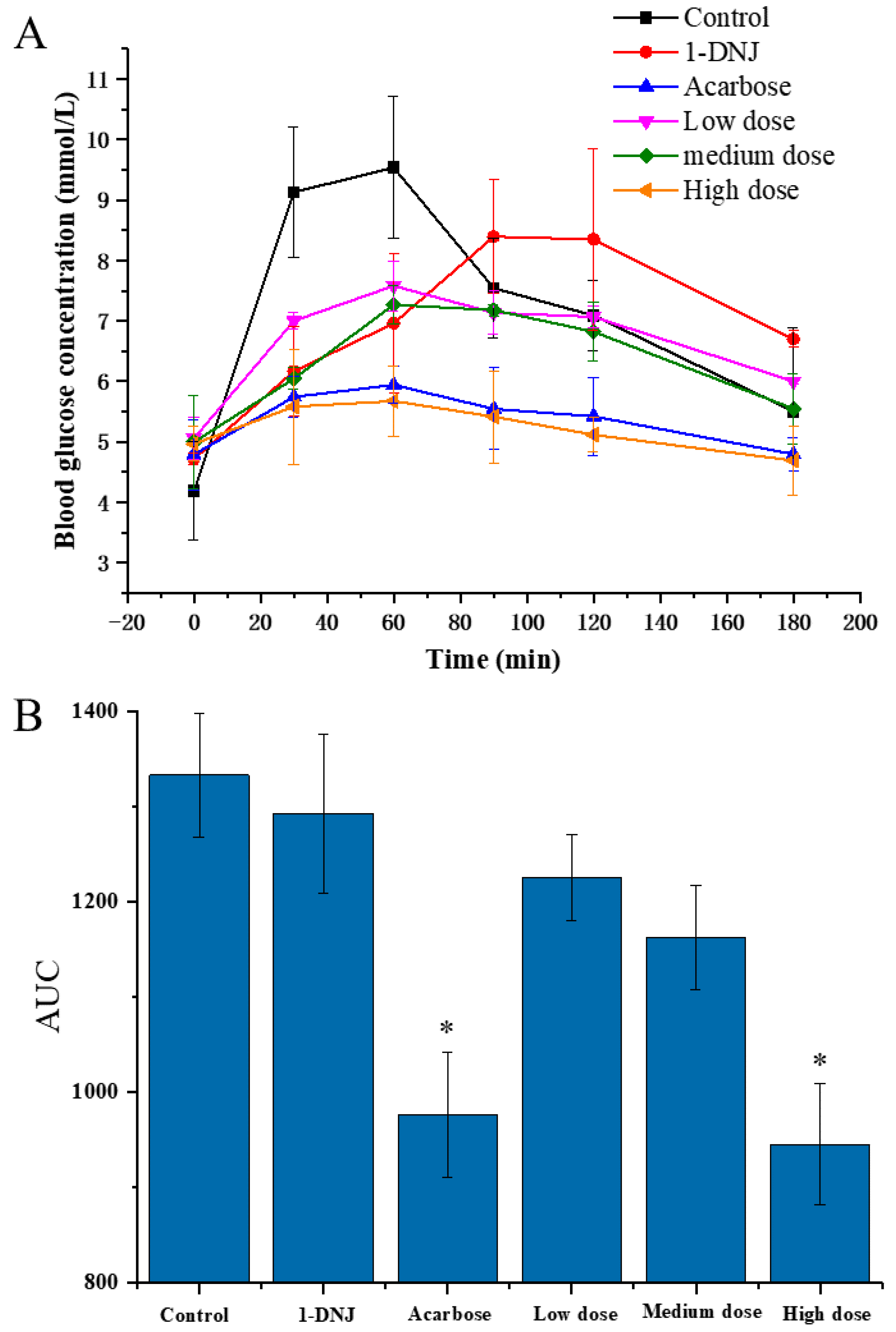
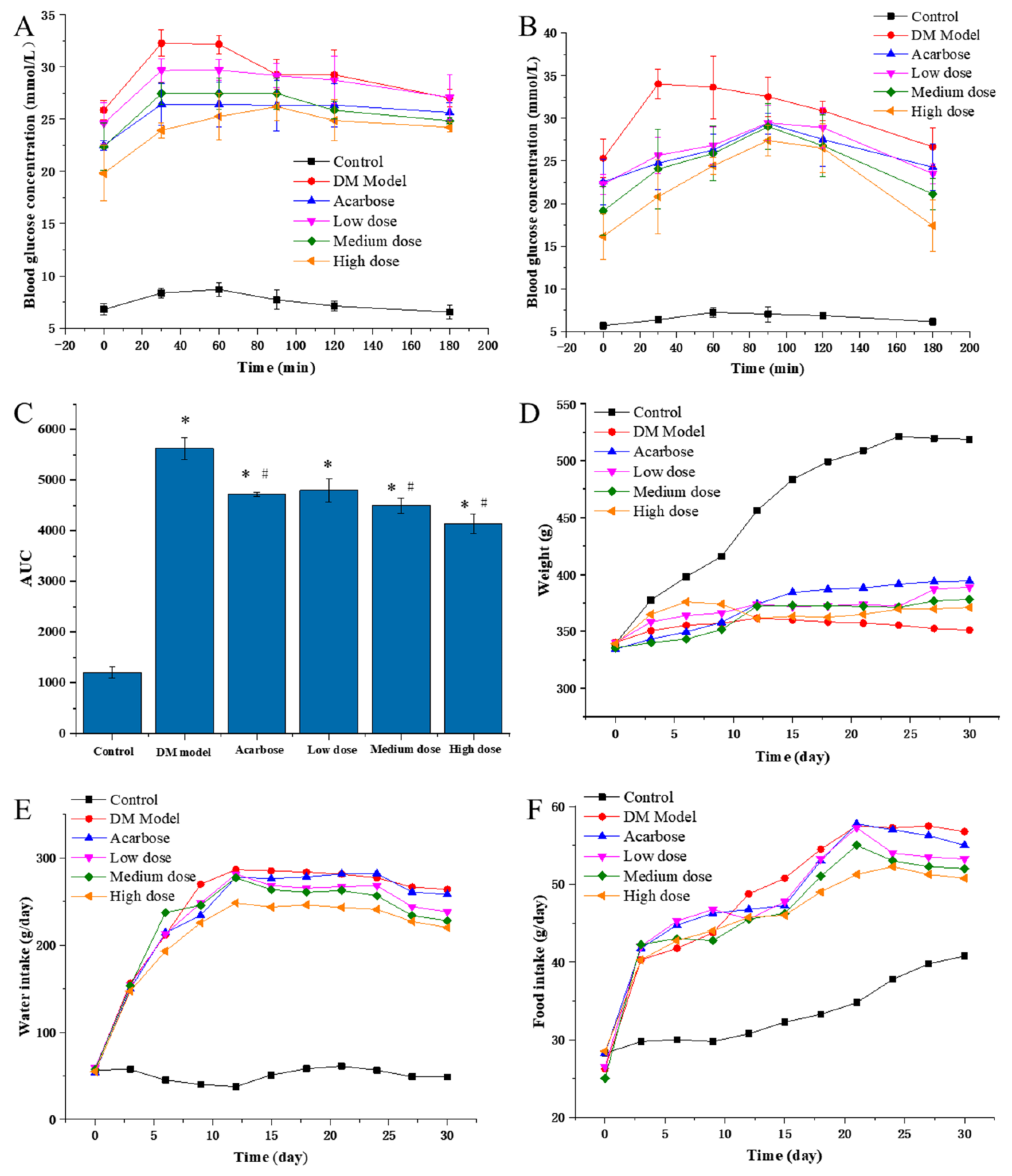
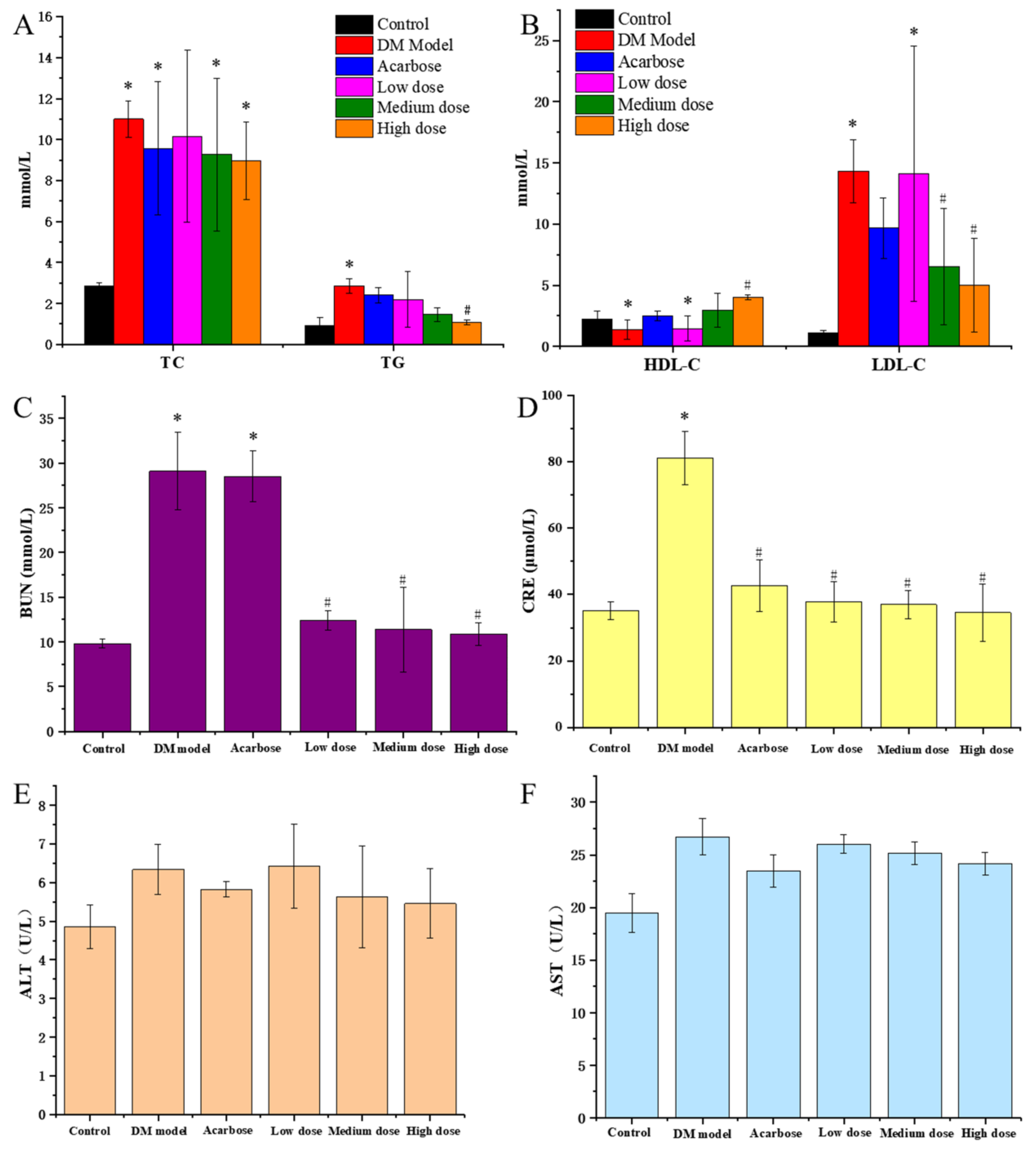
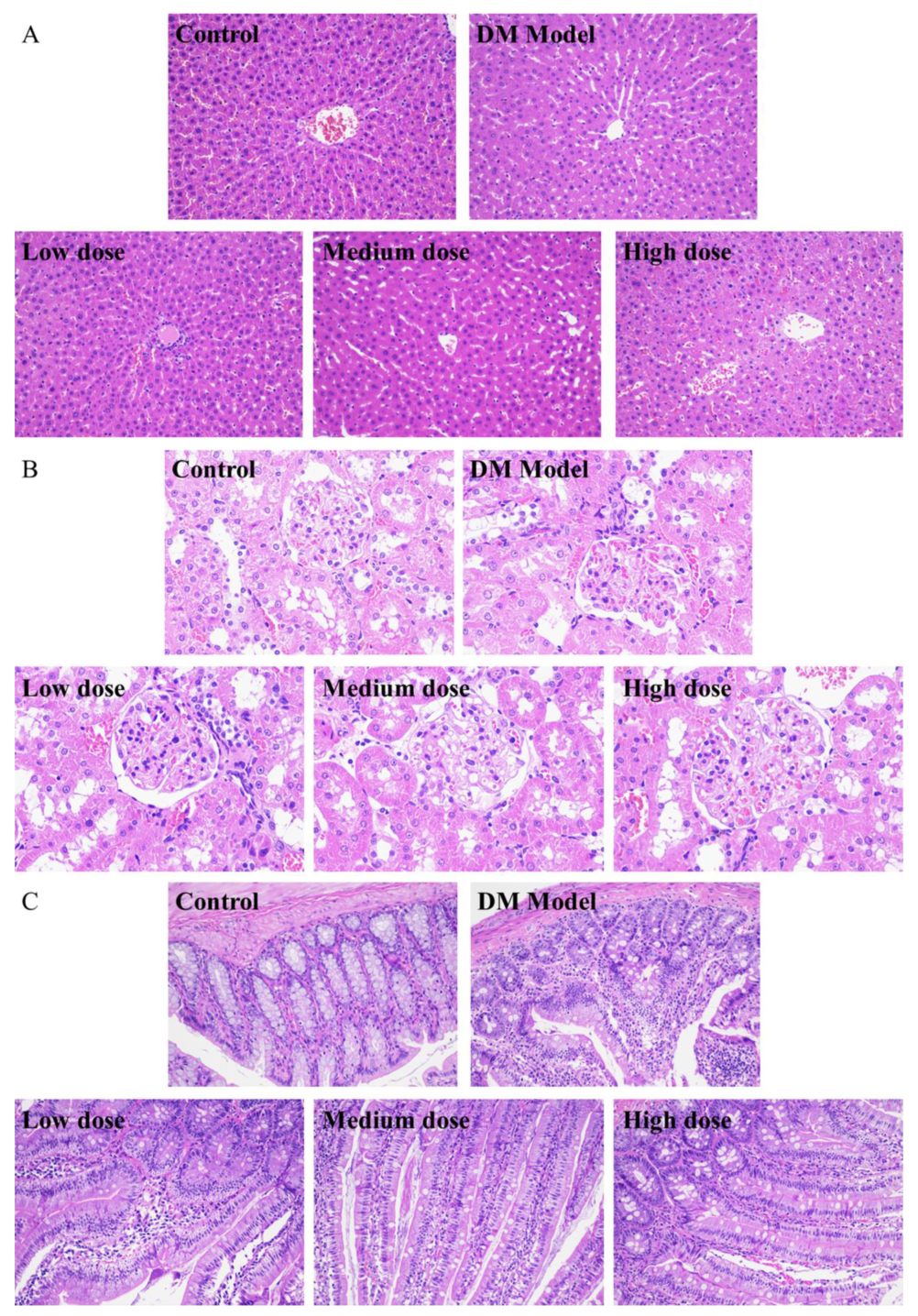
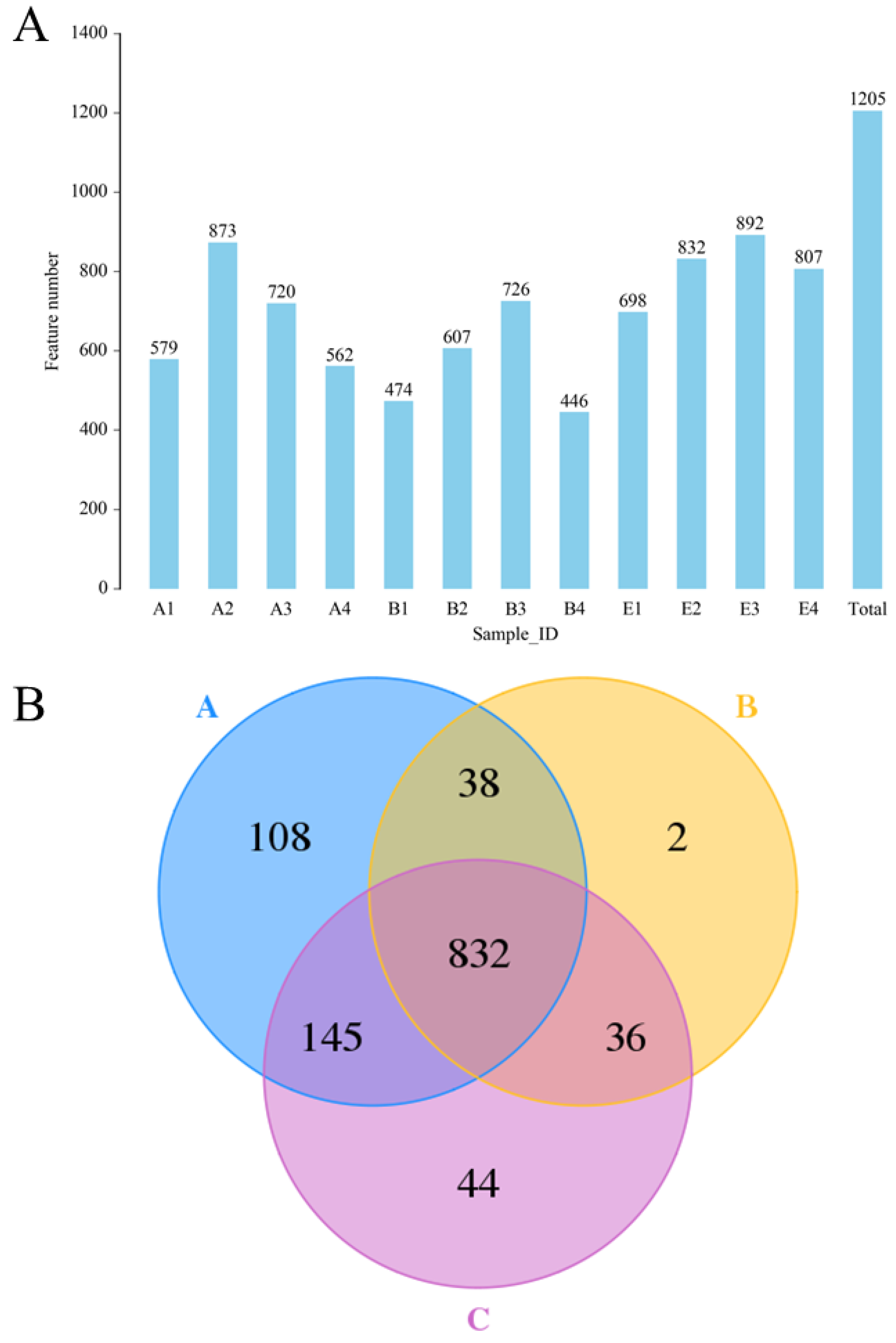
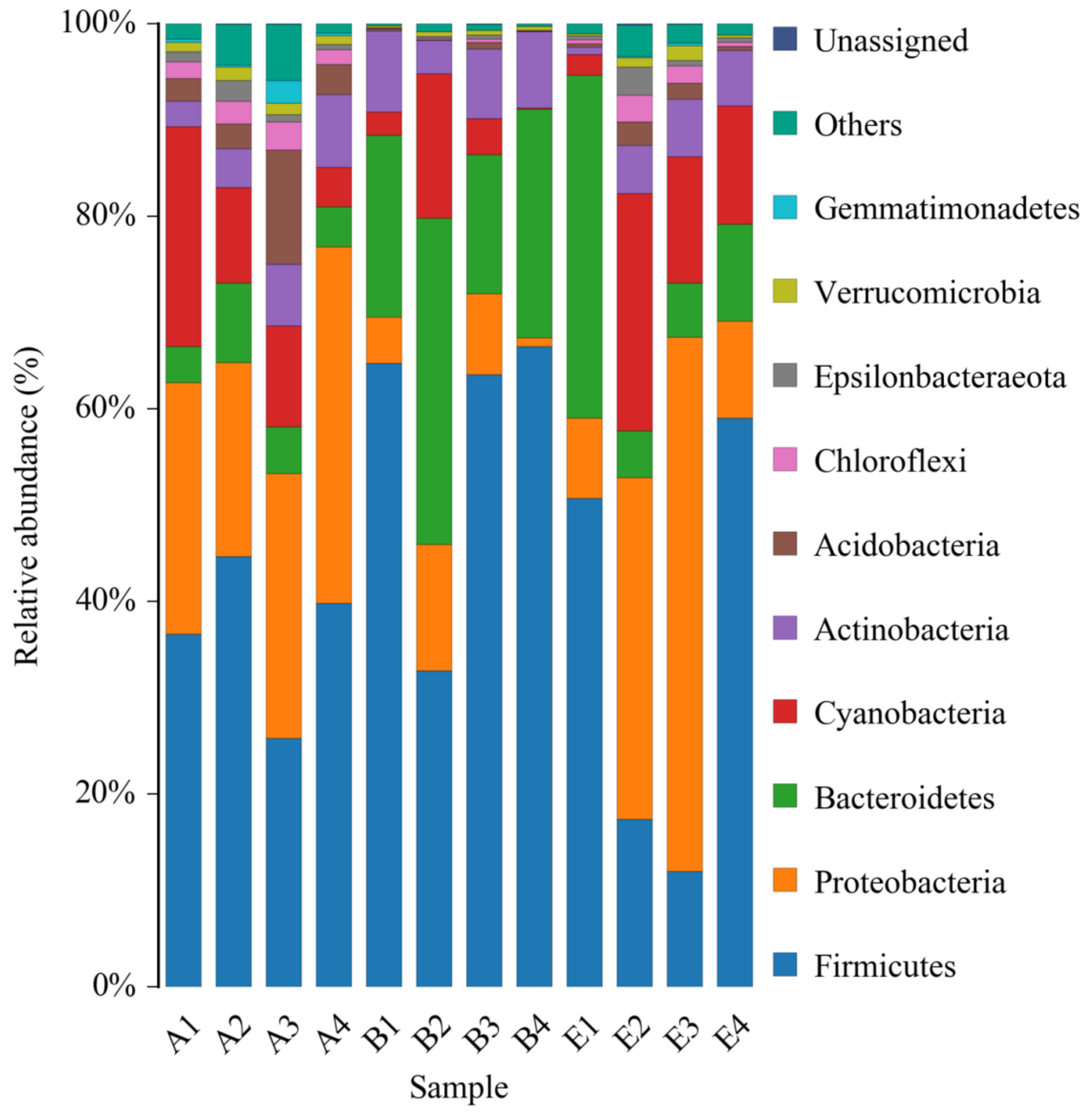
| Gavage Day | Control | DM Model | Acarbose | Low Dose | Medium Dose | High Dose |
|---|---|---|---|---|---|---|
| 1st day | 6.33 ± 0.68 | 14.95 ± 1.61 | 15.06 ± 3.50 | 15.99 ± 3.44 | 15.83 ± 2.54 | 14.25 ± 2.23 |
| 5th days | 6.79 ± 0.53 | 25.86 ± 0.89 | 22.50 ± 0.47 | 24.60 ± 1.93 | 22.37 ± 2.23 | 19.82 ± 2.66 |
| 15th days | 6.11 ± 0.76 | 27.81 ± 2.72 | 26.45 ± 2.30 | 24.78 ± 0.64 | 24.02 ± 2.10 | 21.95 ± 3.07 |
| 20th days | 6.28 ± 0.87 | 28.44 ± 0.41 | 28.14 ± 1.68 | 24.65 ± 1.71 | 24.30 ± 2.86 | 23.33 ± 1.68 |
| 25th days | 6.23 ± 0.60 | 26.26 ± 2.42 | 27.16 ± 2.80 | 20.44 ± 3.58 | 20.46 ± 2.68 | 20.93 ± 4.22 |
| 30th days | 6.17 ± 0.54 | 26.66 ± 2.06 | 24.27 ± 2.78 | 22.28 ± 1.19 | 19.14 ± 2.89 | 16.16 ± 2.72 |
| Organ Name | Control | DM Model | Acarbose | Low Dose | Medium Dose | High Dose |
|---|---|---|---|---|---|---|
| Liver | 3.02 ± 0.13 | 5.29 ± 0.07 | 4.35 ± 0.3 | 4.29 ± 0.37 | 4.59 ± 0.38 | 4.80 ± 0.23 |
| Kidney | 0.68 ± 0.07 | 1.31 ± 0.08 | 1.09 ± 0.06 | 1.19 ± 0.13 | 1.15 ± 0.03 | 1.26 ± 0.14 |
| Feature | ACE | Chao1 | Simpson | Shannon | Coverage | |
|---|---|---|---|---|---|---|
| Control | 684 ± 145 | 811 ± 119 | 798 ± 99 | 0.93 ± 0.04 | 6.35 ± 0.99 | 0.9987 ± 0.0005 |
| DM Model | 563 ± 129 | 670 ± 101 | 687 ± 93 | 0.87 ± 0.04 | 4.39 ± 0.66 * | 0.9983 ± 0.0006 |
| DC-5 | 807 ± 81 | 868 ± 46 # | 884 ± 37 # | 0.90 ± 0.05 | 5.73 ± 0.79 # | 0.9985 ± 0.0006 |
Publisher’s Note: MDPI stays neutral with regard to jurisdictional claims in published maps and institutional affiliations. |
© 2022 by the authors. Licensee MDPI, Basel, Switzerland. This article is an open access article distributed under the terms and conditions of the Creative Commons Attribution (CC BY) license (https://creativecommons.org/licenses/by/4.0/).
Share and Cite
Xiao, P.-J.; Zeng, J.-C.; Lin, P.; Tang, D.-B.; Yuan, E.; Tu, Y.-G.; Zhang, Q.-F.; Chen, J.-G.; Peng, D.-Y.; Yin, Z.-P. Chalcone-1-Deoxynojirimycin Heterozygote Reduced the Blood Glucose Concentration and Alleviated the Adverse Symptoms and Intestinal Flora Disorder of Diabetes Mellitus Rats. Molecules 2022, 27, 7583. https://doi.org/10.3390/molecules27217583
Xiao P-J, Zeng J-C, Lin P, Tang D-B, Yuan E, Tu Y-G, Zhang Q-F, Chen J-G, Peng D-Y, Yin Z-P. Chalcone-1-Deoxynojirimycin Heterozygote Reduced the Blood Glucose Concentration and Alleviated the Adverse Symptoms and Intestinal Flora Disorder of Diabetes Mellitus Rats. Molecules. 2022; 27(21):7583. https://doi.org/10.3390/molecules27217583
Chicago/Turabian StyleXiao, Pin-Jian, Jia-Cheng Zeng, Ping Lin, Dao-Bang Tang, En Yuan, Yong-Gang Tu, Qing-Feng Zhang, Ji-Guang Chen, Da-Yong Peng, and Zhong-Ping Yin. 2022. "Chalcone-1-Deoxynojirimycin Heterozygote Reduced the Blood Glucose Concentration and Alleviated the Adverse Symptoms and Intestinal Flora Disorder of Diabetes Mellitus Rats" Molecules 27, no. 21: 7583. https://doi.org/10.3390/molecules27217583
APA StyleXiao, P.-J., Zeng, J.-C., Lin, P., Tang, D.-B., Yuan, E., Tu, Y.-G., Zhang, Q.-F., Chen, J.-G., Peng, D.-Y., & Yin, Z.-P. (2022). Chalcone-1-Deoxynojirimycin Heterozygote Reduced the Blood Glucose Concentration and Alleviated the Adverse Symptoms and Intestinal Flora Disorder of Diabetes Mellitus Rats. Molecules, 27(21), 7583. https://doi.org/10.3390/molecules27217583







